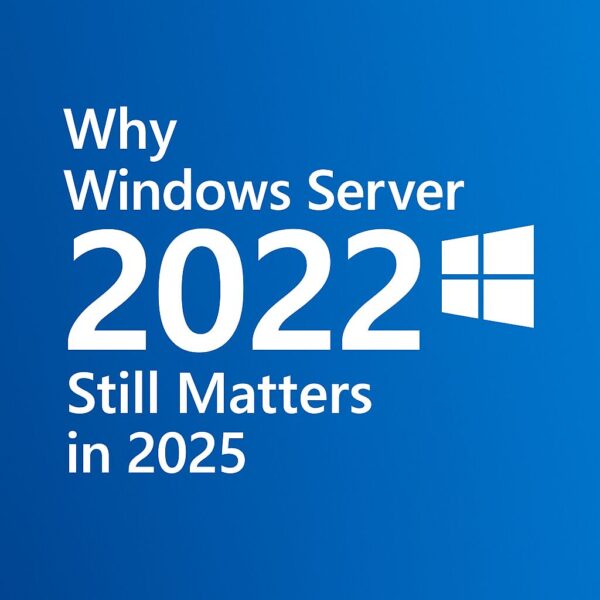
Even in 2025, Windows Server 2022 continues to stand out as one of the most stable, secure, and cloud-ready server operating systems available. While newer versions like Windows Server 2025 are on the horizon, most IT teams favor Server 2022 for its proven reliability, long-term support, and strong hybrid integration.
This article explains why Windows Server 2022 remains relevant, what makes it a powerful choice, and what organizations should consider before deploying it.
- 1 ■ Why Windows Server 2022 Is Still Relevant in 2025
- 2 ■ Security Spotlight: Secured-core Server
- 3 ■ Hybrid Integration with Azure
- 4 ■ Enhanced Storage and Performance
- 5 ■ Virtualization and Container Enhancements
- 6 ■ Editions Comparison
- 7 ■ Before You Deploy: Key Considerations
- 8 ■ 2025 Update: What About Windows Server 2025?
- 9 ■ Conclusion
■ What Is Microsoft Windows Server 2022?
Windows Server 2022, released in August 2021, is a modern server OS designed to support on-premises, hybrid, and cloud workloads. It introduces major improvements in security, virtualization, performance, and Azure integration, making it popular among enterprises of all sizes.
Key goals of Server 2022 include:
- Stronger defense against advanced attacks
- Better performance for mission-critical workloads
- Seamless hybrid cloud capabilities
- Long-term stability and predictable lifecycle
Even as newer OS versions are announced, Server 2022 remains a safe and strategic choice for production environments in 2025.
■ Why Windows Server 2022 Is Still Relevant in 2025
1) Massive Migration After Windows Server 2012 End of Support
Windows Server 2012 / 2012 R2 reached end of support in October 2023, meaning:
- No security updates
- No vulnerability patches
- Compliance risks for regulated industries
For many organizations, Windows Server 2022 became the natural and safe migration target, offering modern security and minimal learning curve.
2) Windows Server 2025 Is Not Fully Production-Ready Yet
Windows Server 2025 is in preview as of mid-2025. Although it introduces exciting new features, it still lacks:
- Broad driver support
- Stability testing in real enterprise environments
- Finalized performance benchmarks
For mission-critical systems, companies continue to trust Server 2022 as the stable production OS while evaluating Server 2025 for the future.
3) Advanced Security and Zero-Trust Architecture
Windows Server 2022 is a Secured-core Server OS, offering multilayered protection:
- TPM 2.0 for hardware-based trust
- UEFI Secure Boot to prevent unauthorized boot code
- Credential Guard using virtualization-based security
- HVCI (Hypervisor-Protected Code Integrity)
- SMB AES-256 Encryption for secure file transfers
These features help defend against ransomware, credential theft, firmware-level attacks, and lateral movement — all major threats in 2025.
4) Perfect Timing for Licensing, Renewals & Infrastructure Refresh
Many companies renew server licenses in 2025 or plan infrastructure upgrades during Q2–Q3.
As a result, Server 2022 adoption continues to peak thanks to:
- Stable maturity
- Predictable lifecycle
- Better pricing than newer versions
- Wide hardware and application compatibility
■ Security Spotlight: Secured-core Server
Secured-core Server is one of Server 2022’s biggest advancements. It adds hardware-rooted trust and protection across multiple layers:
- TPM 2.0 – Protects encryption keys and verifies device identity
- Secure Boot – Stops malicious bootloaders
- Credential Guard – Isolates credentials using VBS
- HVCI – Rejects unsigned or vulnerable kernel drivers
- SMB AES-256-GCM/CCM – Strong encryption for file sharing
This makes Windows Server 2022 ideal for industries with strict security requirements such as finance, healthcare, government, and manufacturing.
■ Hybrid Integration with Azure
Windows Server 2022 simplifies hybrid cloud operations through:
● Azure Arc
- Centralized management for on-premises servers
- Policy enforcement, monitoring, and governance from Azure
● Windows Admin Center (WAC)
- Browser-based server management
- Real-time performance monitoring
- Integrates with Azure Backup, Azure Security, and Azure Update Management
These tools allow organizations to gradually transition toward cloud-native workloads without abandoning existing on-premises assets.
■ Enhanced Storage and Performance
Server 2022 includes improvements especially valuable for large-scale storage or virtualization environments:
- SMB Compression – Faster file transfers by compressing data on the fly
- Adjustable Storage Repair Speed – Fine control over data resync in Storage Spaces Direct
- Improved Failure Recovery – Faster repair in cluster or disk failures
- SMB over QUIC support – Faster, secure file sharing over the public internet
■ Virtualization and Container Enhancements
To support modern DevOps and cloud-native apps, Server 2022 introduces:
- Smaller Windows Container Image (up to 40% smaller, 30% faster startup)
- Improved Kubernetes support
- Nested Virtualization for AMD processors
- Better compatibility with .NET applications
These improvements make Server 2022 more efficient for organizations using containerized workloads or hybrid development pipelines.
■ Editions Comparison
| Edition | Target Users | Key Features |
|---|---|---|
| Essentials | Small businesses | Up to 25 users / 50 devices, no CALs required |
| Standard | SMBs | Supports 2 VMs + 1 Hyper-V host |
| Datacenter | Large enterprises | Unlimited VMs, advanced storage + virtualization |
| Datacenter: Azure Edition | Hybrid/cloud environments | Deep Azure integration, hotpatching, storage improvements |
■ Before You Deploy: Key Considerations
- Hardware Requirements
64-bit CPU, at least 2 GB RAM, 32 GB storage (production use requires higher specs) - Lifecycle Support
- Mainstream support: Until October 13, 2026
- Extended support: Until October 14, 2031
- Compatibility
Supports most enterprise apps built for Windows Server 2016/2019 - Security Best Practices
TPM 2.0, Secure Boot, virtualization-based security (VBS) recommended
■ 2025 Update: What About Windows Server 2025?
As of mid-2025:
- Windows Server 2025 is still in Preview (Preview 3)
- Official release expected late 2025
- Many features and licensing rules are still unconfirmed
Due to this uncertainty, organizations continue to adopt Windows Server 2022 as their primary production OS while testing Server 2025 in isolated environments.
■ Conclusion
Windows Server 2022 remains one of the best-balanced server operating systems in 2025 — combining stability, security, hybrid readiness, and broad compatibility. Whether upgrading from Server 2012/2016/2019 or deploying new infrastructure, Server 2022 offers a solid foundation for today’s workloads and tomorrow’s cloud strategies.
If you need proven reliability with future flexibility, Windows Server 2022 continues to be a smart choice.
✔️You might also find these helpful:
▶︎Windows PC Booting Too Slow? 7 Ways to Fix It for Beginners
▶︎Fix Microsoft Store Error 0x80073D02 on Windows 11
▶︎Wi-Fi Connected but No Internet? Fix It with These 7 Simple Steps


![How to Replace Your PC’s SSD by Yourself [2025 Guide]](https://kimiyoya.com/wp-content/uploads/2025/03/1F1DB572-A366-4D42-9563-B53FD67205FC-375x375.jpg)